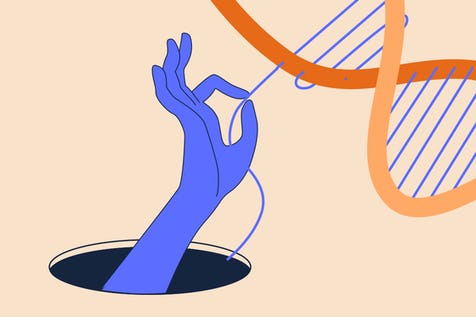Approaching menopause can be a bittersweet experience—it's goodbye to periods and pads but also hello to other not-so-pleasant changes.
Menopause refers to the point of your life when your periods have naturally and permanently stopped for 12 months in a row [1]. This is one of the most well-known stages of a woman's life that reflects the end of their reproductive period.
It's common for women to think that they've undergone menopause when they begin experiencing symptoms characteristic of this stage of life. But that's not accurate.
If you're experiencing menopause-like symptoms but your periods have not yet ceased for 12 months in a row—that's perimenopause, also known as the menopausal transition.
"Peri" comes from Greek and translates to "about" or "around." So, perimenopause is the time around menopause that encompasses the final years of your reproductive life [2].
In this article, we'll explore the signs and symptoms you may experience during menopause and perimenopause, how long each stage lasts, and how your hormones will change throughout these phases.
When Does Menopause Start?
The average age at which women experience menopause is 51. However, some women may have early menopause between 40 and 45 years of age [1].
But how long does menopause usually last?
Well, menopause refers to the point of time when you've not had a period for 12 months in a row. After menopause occurs, you'll step into a phase known as postmenopause. This postmenopausal period is marked by amenorrhea, which is the absence of menstruation [1].
As you enter postmenopause, you may still experience menopausal symptoms. In fact, research has shown that hot flashes and night sweats (which are common menopausal symptoms) can last for more than 4 years after the final menstrual period (FMP) in many women—which is over 3 years into postmenopause [4].
When Does Perimenopause Start?
Menopausal transition, or perimenopause, can be divided into two stages, early and late. The average age for early-stage menopausal transition is 47, while the average age for late-stage menopausal transition is 49 [2].
In short, women usually enter the perimenopause stage in their late 40s, though this may vary due to factors such as race and ethnicity. Women who smoke are also more likely to experience menopause 1-2 years earlier than those who don't [5].
But how long does perimenopause last?
On average, the menopause transition will generally begin 4-6 years before your periods stop completely [6]. During the early phase of perimenopause, your menstrual patterns will begin to change. And once you enter the late perimenopause stage, your periods will become scarce and will occur months apart [2].
Upon reaching menopause, you'll no longer experience periods for the rest of your life.
Many women celebrate graduating past the 'pads-and-tampons' stage of life. But at the same time, it's perfectly normal to have concerns about the menopause-related symptoms you may experience along the way.
Signs And Symptoms Of Menopause And Perimenopause
From changes in your body composition and weight to alterations in your cycle, periods, and hormonal levels—your body is navigating a unique transition as your reproductive system begins to take the backseat.
The symptoms of perimenopause, menopause, and postmenopause often overlap. Here's a list of the most common menopause-related symptoms you may experience.
Irregular periods
It is common to have irregular periods as you approach menopause due to the changes in hormone levels.
During the early perimenopause phase, you may notice that your cycle lengths begin to vary by more than 7 days. Meanwhile, the late perimenopause phase is characterised by menses that occur over 60 days apart [2].
Hot flashes and night sweat
Hot flashes refer to the sudden flare of heat in your upper body, which can be accompanied by sweating and a flushed face. An episode typically lasts less than 5 minutes [9]. Meanwhile, night sweats refer to hot flashes that occur at night.
Up to 80% of women will experience hot flashes and night sweats while undergoing menopause, making it one of the most common menopausal symptoms [4]. Some women experience episodes that are severe enough to disrupt their daily activities and sleep.
Affected sleep
As you approach menopause, you may experience sleep difficulties. Waking up in the middle of the night is the most common sleep problem, but you may also find it harder to fall asleep at night [8].
Night sweats may keep you tossing and turning at night. But day-to-day stress and changes in your hormone levels can also impact your quality of sleep [8].
Changes in mood
During the menopausal transition phase, some research has suggested that some women are at a higher risk of experiencing anxiety, depression, and stress [2].
If you find yourself constantly plagued by sleep disturbances, this could contribute to changes in mood and depression as well [2].
Changes in memory and brain function
Brain fog, forgetfulness, and memory problems are common complaints of women undergoing transition into menopause [6].
Research suggests that hormonal changes during menopause could be the culprit for these brain-related symptoms. However, there is still conflicting research evidence on the impact of estrogen levels on memory and brain function. Alternatively, a lack of sleep and reduced sleep quality during perimenopause could be the cause [6].
Weight gain
Some women experience weight gain around the time of menopause, but undergoing menopause itself isn't the exact cause of weight gain [10]. More often than not, any weight gain is multifactorial—meaning that it's due to a combination of factors, such as changes in diet or exercise.
However, the hormonal changes during perimenopause can increase your total body fat and the fat in your abdominal area. During this time, body fat tends to be stored around your abdomen, changing the shape and appearance of your body [10].
Understandably, your self-esteem and body image may be affected, which can be challenging to navigate.
Hair loss
Some women may experience hair loss when approaching menopause [12]. Your existing hair may also become thinner and drier, and you may notice reduced hair on your scalp and a slower rate of hair regrowth. This may also be accompanied by unwanted hair growth on other parts of the body [12].
Decreased sex drive and vaginal dryness
As you undergo menopause transition, your sex drive may take a hit. At this stage of life, it's very common for women to have reduced libido [13].
The dip in estrogen can also result in a slow or reduced orgasmic response. Hence, some women begin to feel that sex has lost its kick [13].
On top of that, you may observe minimal or delayed vaginal secretion, vaginal dryness, bleeding after sex, and painful uterine contractions (for women aged 60-70) [13]. Cumulatively, this can make sex painful, uncomfortable, and less enjoyable.
Nonetheless, some of these symptoms, such as painful uterine contractions and bleeding after sex may also be telltale signs of an underlying illness. Thus, it's best to get such symptoms checked by your healthcare professional.
Headaches
A migraine is a primary headache disorder that is often associated with hormone fluctuations. Hence, some women may experience worsening migraines during perimenopause, though this usually improves in late menopause [14].
Anxiety, depression, or sleep problems during menopause may also exacerbate this condition [14].
Irregular heartbeat
Heart palpitations refer to the feeling of an abnormal, rapid, or irregular beating of the heart. Heart palpitations are not widely spoken about, so they may catch you by surprise. However, women in the perimenopause or postmenopause stage can experience this [15].
You may notice your heart flutter, pound, race, or skip a beat—and no, it's not because someone attractive has just walked by. While heart palpitations may not necessarily signify a serious problem, it's still best to get them checked out by your doctor to rule out any harmful underlying causes.
Sore nipples and breast pain
Breast discomfort, pain, or tenderness are more common in the early perimenopause phase compared to the late perimenopause stage [16]. You may also notice changes in the shape, size, and appearance of your breasts.
Can these symptoms be treated?
The fact is, some women breeze through these stages of menopause with mild symptoms that can be easily managed with lifestyle changes. For instance, avoiding alcohol and spicy foods or wearing loose, breathable clothing may sufficiently help with hot flashes and night sweats [9]
On the other hand, some women may experience frustratingly severe symptoms that can hamper their quality of life. Thus, they may require treatment like hormone therapy for more serious cases of hot flashes or the use of sleep medications for menopause-related insomnia [6].
If you've begun experiencing symptoms that affect your mood, sleep, and overall quality of life, it's best to take this to a healthcare professional. They'll be able to recommend lifestyle changes or treatment options to tackle some of those symptoms.
Can I Still Get Pregnant During Perimenopause Or After Menopause?
Yes, you can still get pregnant during perimenopause.
While your fertility has dwindled significantly since your 20s or 30s, it's still possible to naturally conceive while in perimenopause. The likelihood of pregnancy without contraception is about 10% at 40-44 years of age. But this drops to just 2-3% at ages 45-49 [18].
In perimenopause, you will notice your cycles becoming highly irregular. And in its late stage, you may not even get your menses for months. Many women believe this marks the end of their reproductive capabilities and decide that it's time to shelve their birth control.
However, you could technically still get pregnant with unprotected sexual intercourse until you go 12 months without a menstrual period—which is when you've reached menopause.
Once you reach menopause, it is not possible for you to get pregnant naturally, but it may be possible through assisted reproductive therapy (ART), such as in vitro fertilisation (IVF) with the use of donor eggs [18].
Why Does Menopause Happen?
Menopause is a natural part of the ageing process. Eventually, your ovaries decide it's finally time to call it a day, and they no longer release mature eggs for fertilisation (ovulation).
And why does this happen?
Well, you're born with a fixed number of primordial follicles in your ovaries, which is around 2 million at birth. A primordial follicle is an egg-containing pod that can develop to release a mature egg. This reserve of follicles depletes as you grow older. Nearing menopause, you'll only have around 1000 of these follicles left [5].
Eventually, the remaining follicles in your ovaries succumb to the biological clock and rapidly die off. This happens until all the follicles have died off, so ovulation can no longer occur—which also means you'll no longer be able to naturally conceive [5].
To sum it up, the hallmark of menopause is the absence of any menstrual periods for 12 or more months. This happens as ovulation can no longer occur after menopause due to the depletion of the follicular reserve in your ovaries. Due to these changes, your ovaries will also stop producing two female sex hormones, estrogen and progesterone.
On a side note, ovulation still occurs during perimenopause, which is why there's a possibility of you getting pregnant during that stage. During perimenopause, you may notice different symptoms of ovulation. One symptom of ovulation you may notice includes changes in the colour and texture of your cervical mucus, which becomes clear, stretchy, and slippery around the time of ovulation [20].
Hormonal Changes During Menopause
So what hormonal changes take place when your ovaries decide to—or rather, are forced to—retire?
During the menopausal transition, here's how your hormone levels change:
|
Event |
Consequence |
|
As your reserve of follicles depletes, a lower amount of a hormone, inhibin B, is released [2]. |
Inhibin B blocks the secretion of another hormone called follicle-stimulating hormone (FSH). Since there is less inhibin B, the concentration of FSH increases [2]. |
|
The levels of FSH remain high throughout perimenopause and post-menopause [21]. |
The high levels of FSH during perimenopause lead to irregular cycles and menses [2]. |
|
Your ovaries stop producing estrogen, and the levels of estrogen fluctuate and will eventually decline to a very low level [2]. |
A low level of estrogen can lead to irregular periods and cycles. Additionally, some health concerns related to low estrogen include sexual problems [3]. |
|
Your ovaries will also stop producing progesterone, causing its level to fall [2]. |
Low progesterone levels may be associated with mood changes in perimenopause. Additionally, low progesterone levels in addition to high estrogen (unopposed estrogen) can cause heavy bleeding during perimenopause [17, 19]. |
These hormone changes can lead to the various symptoms you experience during perimenopause and menopause, such as hot flashes and irregular menses.
Why should I track my cycle?
Being able to track your cycle as you enter your 40s will help you better understand your normal cycles before menopause. You'll also be able to detect changes and irregularities in your cycle, which may signify that you're approaching menopause.
The inne minilab is an ovulation and cycle-tracking device that operates via simple saliva tests. On top of that, the inne app also allows you to easily record your daily symptoms, mood, and sex drive.
With this information, you'll be able to keep a record of your cycle and symptoms for your healthcare provider.
Ultimately, the inne minilab offers a simple way to better engage with your physical and sexual wellness, especially as you approach a new stage of life!
References
1. Peacock K, Ketvertis KM. Menopause. [Updated 2022 Feb 2]. In: StatPearls [Internet]. Treasure Island (FL): StatPearls Publishing; 2022 Jan-. Available from: https://www.ncbi.nlm.nih.gov/books/NBK507826
2. Santoro N. Perimenopause: From Research to Practice. J Womens Health (Larchmt). 2016;25(4):332-339. doi:10.1089/jwh.2015.5556
3. Dalal PK, Agarwal M. Postmenopausal syndrome. Indian J Psychiatry. 2015;57(Suppl 2):S222-S232. doi:10.4103/0019-5545.161483
4. Avis NE, Crawford SL, Greendale G, et al. Duration of menopausal vasomotor symptoms over the menopause transition. JAMA Intern Med. 2015;175(4):531-539. doi:10.1001/jamainternmed.2014.8063
5. Gold EB. The timing of the age at which natural menopause occurs. Obstet Gynecol Clin North Am. 2011;38(3):425-440. doi:10.1016/j.ogc.2011.05.002
6. Gava G, Orsili I, Alvisi S, Mancini I, Seracchioli R, Meriggiola MC. Cognition, Mood and Sleep in Menopausal Transition: The Role of Menopause Hormone Therapy. Medicina (Kaunas). 2019;55(10):668. Published 2019 Oct 1. doi:10.3390/medicina55100668
7. Delamater L, Santoro N. Management of the Perimenopause. Clin Obstet Gynecol. 2018;61(3):419-432. doi:10.1097/GRF.0000000000000389
8. Baker FC, Lampio L, Saaresranta T, Polo-Kantola P. Sleep and Sleep Disorders in the Menopausal Transition. Sleep Med Clin. 2018;13(3):443-456. doi:10.1016/j.jsmc.2018.04.011
9. Lugo T, Tetrokalashvili M. Hot Flashes. [Updated 2021 Dec 28]. In: StatPearls [Internet]. Treasure Island (FL): StatPearls Publishing; 2022 Jan-. Available from: https://www.ncbi.nlm.nih.gov/books/NBK539827/
10. Davis SR, Castelo-Branco C, Chedraui P, et al. Understanding weight gain at menopause. Climacteric. 2012;15(5):419-429. doi:10.3109/13697137.2012.707385
12. Zouboulis CC, Blume-Peytavi U, Kosmadaki M, et al. Skin, hair and beyond: the impact of menopause [published online ahead of print, 2022 Apr 4]. Climacteric. 2022;1-9. doi:10.1080/13697137.2022.2050206
13. Leventhal JL. Management of Libido Problems in Menopause. Perm J. 2000;4(3):29-34.
14. Pavlović JM. Evaluation and management of migraine in midlife women. Menopause. 2018;25(8):927-929. doi:10.1097/GME.0000000000001104
15. Sheng Y, Carpenter JS, Elomba CD, et al. Review of menopausal palpitations measures. Womens Midlife Health. 2021;7(1):5. Published 2021 May 31. doi:10.1186/s40695-021-00063-6
16. Crandall CJ, Markovic D, Huang MH, Greendale GA. Predictors of breast discomfort among women initiating menopausal hormone therapy. Menopause. 2010;17(3):462-470. doi:10.1097/gme.0b013e3181c29e68
17. Joffe H, de Wit A, Coborn J, et al. Impact of Estradiol Variability and Progesterone on Mood in Perimenopausal Women With Depressive Symptoms. J Clin Endocrinol Metab. 2020;105(3):e642-e650. doi:10.1210/clinem/dgz181
18. Tower C. Pregnancy in peri- and postmenopausal women: challenges in management. Menopause Int. 2009;15(4):165-168. doi:10.1258/mi.2009.009040
19. Hale GE, Manconi F, Luscombe G, Fraser IS. Quantitative measurements of menstrual blood loss in ovulatory and anovulatory cycles in middle- and late-reproductive age and the menopausal transition. Obstet Gynecol. 2010;115(2 Pt 1):249-256. doi:10.1097/AOG.0b013e3181ca4b3a
20. Fehring RJ, Mu Q. Cohort efficacy study of natural family planning among perimenopause age women. J Obstet Gynecol Neonatal Nurs. 2014;43(3):351-358. doi:10.1111/1552-6909.12307.
21. Burger HG, Hale GE, Robertson DM, Dennerstein L. A review of hormonal changes during the menopausal transition: focus on findings from the Melbourne Women's Midlife Health Project. Hum Reprod Update. 2007;13(6):559-565. doi:10.1093/humupd/dmm020

.jpg)





